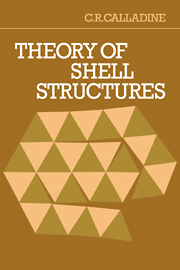Book contents
- Frontmatter
- Contents
- Preface
- List of symbols
- 1 Introduction
- 2 Generalised Hooke's law for an element of a shell
- 3 Cylindrical shells under symmetric loading
- 4 Purely ‘equilibrium’ solutions for shells: the membrane hypothesis
- 5 The geometry of curved surfaces
- 6 Geometry of distortion of curved surfaces
- 7 Displacements of elastic shells stressed according to the membrane hypothesis
- 8 Stretching and bending in cylindrical and nearly-cylindrical shells
- 9 Problems in the behaviour of cylindrical and nearly-cylindrical shells subjected to non-symmetric loading
- 10 Cylindrical shell roofs
- 11 Bending stresses in symmetrically-loaded shells of revolution
- 12 Flexibility of axisymmetric bellows under axial loading
- 13 Curved tubes and pipe-bends
- 14 Buckling of shells: classical analysis
- 15 Buckling of shells: non-classical analysis
- 16 The Brazier effect in the buckling of bent tubes
- 17 Vibration of cylindrical shells
- 18 Shell structures and the theory of plasticity
- Appendices
- Answers to selected problems
- References
- Index
2 - Generalised Hooke's law for an element of a shell
Published online by Cambridge University Press: 02 February 2010
- Frontmatter
- Contents
- Preface
- List of symbols
- 1 Introduction
- 2 Generalised Hooke's law for an element of a shell
- 3 Cylindrical shells under symmetric loading
- 4 Purely ‘equilibrium’ solutions for shells: the membrane hypothesis
- 5 The geometry of curved surfaces
- 6 Geometry of distortion of curved surfaces
- 7 Displacements of elastic shells stressed according to the membrane hypothesis
- 8 Stretching and bending in cylindrical and nearly-cylindrical shells
- 9 Problems in the behaviour of cylindrical and nearly-cylindrical shells subjected to non-symmetric loading
- 10 Cylindrical shell roofs
- 11 Bending stresses in symmetrically-loaded shells of revolution
- 12 Flexibility of axisymmetric bellows under axial loading
- 13 Curved tubes and pipe-bends
- 14 Buckling of shells: classical analysis
- 15 Buckling of shells: non-classical analysis
- 16 The Brazier effect in the buckling of bent tubes
- 17 Vibration of cylindrical shells
- 18 Shell structures and the theory of plasticity
- Appendices
- Answers to selected problems
- References
- Index
Summary
Introduction
We are now ready to establish the mechanical properties of a typical small element of a thin uniform elastic shell. We have already decided to replace the shell itself by a model consisting of a surface, and we must now furnish this surface with appropriate mechanical properties.
This task is equivalent to the well-known piece of work in the classical theory of beams in which the beam is shown to be equivalent to a ‘line’ endowed with a flexural stiffness EI, where E is Young's modulus of elasticity of the material and I is a geometrical property of the cross-section. But the present task is more complex than the corresponding one for the beam, in two distinct ways. First, an element of a shell is two dimensional, whereas an element of a beam is one dimensional. Second, an element of shell is in general curved rather than flat.
A basic idea, which was proposed in the early days of shell theory, is that in relation to the specification of the mechanical properties of an element of a shell it is legitimate to proceed as if the element were flat, and not curved. Legitimate, that is, as a ‘first approximation’. Much work has been done by many authors on the question of the degree of inaccuracy which is introduced by this idea: see, for example, Novozhilov (1964), Naghdi (1963). We shall not attempt to justify this idea formally.
- Type
- Chapter
- Information
- Theory of Shell Structures , pp. 12 - 39Publisher: Cambridge University PressPrint publication year: 1983

